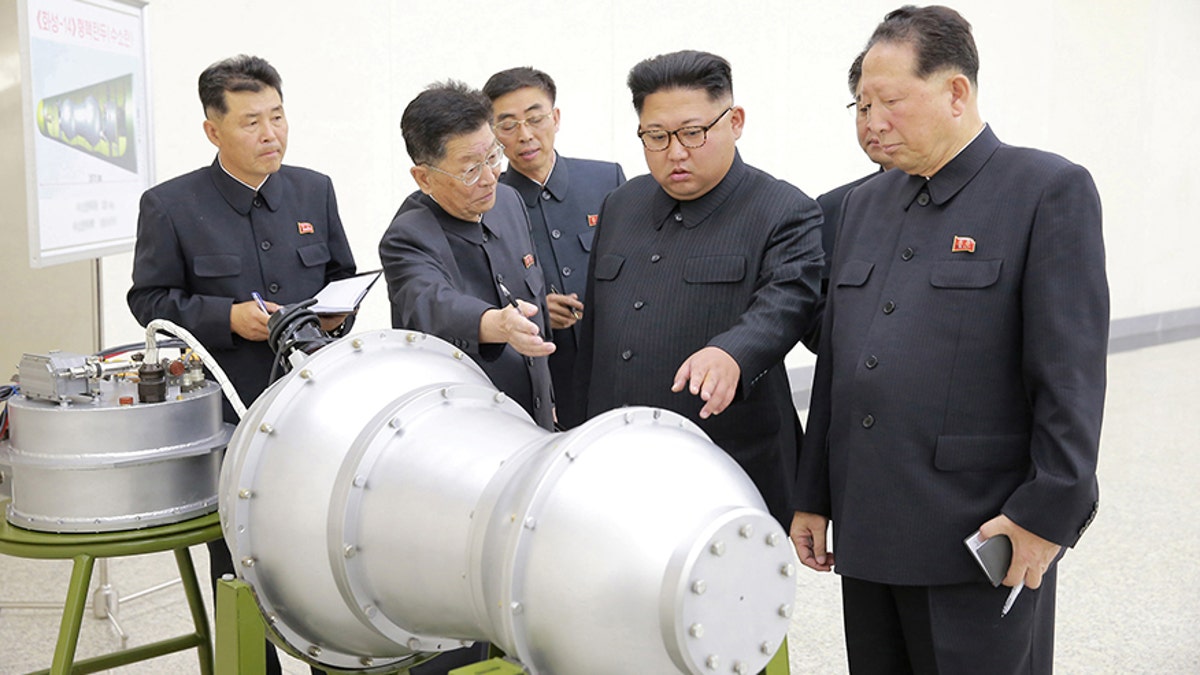The Doomsday Clock: What is it and why it sped up
The Bulletin of the Atomic Scientists has officially sped up the world’s Doomsday Clock, citing world leaders’ failure to deal with threats of nuclear war. Here’s a brief history of what the clock symbolizes and how it started.
The Doomsday Clock was moved on Thursday to two minutes to midnight – marking the closest the symbolic point of global Armageddon that the clock represents has reached since 1953.
Citing President Trump’s proactive rhetoric toward fellow global powers, North Korea’s continuing nuclear weapon and ballistic missile tests and heightened tensions between the U.S. and Russia, members of the Bulletin of the Atomic Scientists said that the world is the closest it has ever been to nuclear annihilation.
“To call the nuclear situation in the world dire is an understatement,” Rachel Bronson, the president of the Bulletin of the Atomic Scientists said at a press conference Thursday in Washington D.C. “It is now two minutes to midnight—the closest the Clock has ever been to Doomsday, and as close as it was in 1953, at the height of the Cold War.”
The Doomsday Clock, which was first introduced in 1947 to represent the threat of a global nuclear war, has in recent years begun to also include climate change, emerging biotechnologies, and cybertechnology that could irrevocably harm life on this planet. The clock was farthest from midnight in 1991, when it was moved back to 17 minutes after the U.S. and Soviet Union signed the first Strategic Arms Reduction Treaty.
SCIENTISTS HAVE A NEW THEORY ON HOW THE CHERNOBYL DISASTER UNFOLDED
Since then – given continued spending on nuclear arsenals, a speeding up of global climate change and mounting instability on the world stage – the clock has slowly crept closer to midnight.
In 2017, the Bulletin moved the clock from 3 minutes to midnight to 2 and half minutes amid comments from Trump on North Korea and fears of a renewed nuclear arms race with Russia. It was the first time the clock had been moved in over two years.

North Korean leader Kim Jong Un provides guidance with Ri Hong Sop (2nd L) and Hong Sung Mu (R) on a nuclear weapons program in this undated photo released by North Korea's Korean Central News Agency (KCNA) in Pyongyang September 3, 2017. KCNA via REUTERS ATTENTION EDITORS - THIS PICTURE WAS PROVIDED BY A THIRD PARTY. REUTERS IS UNABLE TO INDEPENDENTLY VERIFY THE AUTHENTICITY, CONTENT, LOCATION OR DATE OF THIS IMAGE. NOT FOR SALE FOR MARKETING OR ADVERTISING CAMPAIGNS. NO THIRD PARTY SALES. NOT FOR USE BY REUTERS THIRD PARTY DISTRIBUTORS. SOUTH KOREA OUT. NO COMMERCIAL OR EDITORIAL SALES IN SOUTH KOREA. THIS PICTURE IS DISTRIBUTED EXACTLY AS RECEIVED BY REUTERS, AS A SERVICE TO CLIENTS. TPX IMAGES OF THE DAY - RC18A8521C80 (Reuters)
Trump was faulted this year as well for the clock moving forward, with the organization blaming the president’s statements and social media posts for fueling tensions with North Korea and other nuclear powers. The president has drawn heavy criticism for his war of words with North Korean strongman Kim Jong Un, especially after his tweet earlier this month where he boasted that he has a bigger and more powerful "nuclear button" than the leader in Pyongyang.
“In the past year, U.S. allies have needed reassurance about American intentions more than ever,” said Sharon Squassoni, a professor at George Washington University’s Elliott School of International Affairs.
EVEN WITHOUT EL NINO LAST YEAR, EARTH KEEPS WARMING
“Instead, they have been forced to negotiate a thicket of conflicting policy statements from a U.S. administration weakened in its cadre of foreign policy professionals, suffering from turnover in senior leadership, led by an undisciplined and disruptive president, and unable to develop, coordinate, and clearly communicate a coherent nuclear policy” she added.
The White House did not return Fox News’ request for comment on this story.
The panel at the Bulletin also noted that 2017’s environmental disasters contributed to the moving of the clock toward midnight – specifically noting the Caribbean’s devastating hurricane season, massive wildfires in the U.S. and Canada, heat waves across the globe and the rapidly shrinking Arctic ice caps as major contributors.
“While this was happening, the Trump administration dutifully carried through on the campaign promise of derailing U.S. climate policy, putting avowed climate denialists in top cabinet positions, and announcing plans to withdraw from the Paris climate Agreement,” Sivan Kartha, a senior scientist at the Stockholm Environmental Institute, said. “Thankfully, this didn’t cause global cooperation to unravel, and other countries have reaffirmed their commitment to take action against climate change.”
Despite the grim outlook, the panel assembled Thursday in Washington said there are steps the global community can take to bring the world back from the brink, including starting talks between the U.S. and North Korea, resolving the U.S. and Russia’s differences over the Intermediate-Range Nuclear Forces Treaty and redoubling efforts to reduce greenhouse gas emissions.
“It is not yet midnight and we have come back from the brink before,” Lawrence Krauss, the director of the Origins Project at Arizona State University and the chair of the Bulletin of the Atomic Scientists’ Board of Sponsors, said. “It is up to us to do this.”









































